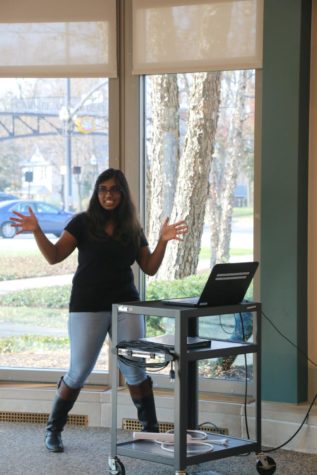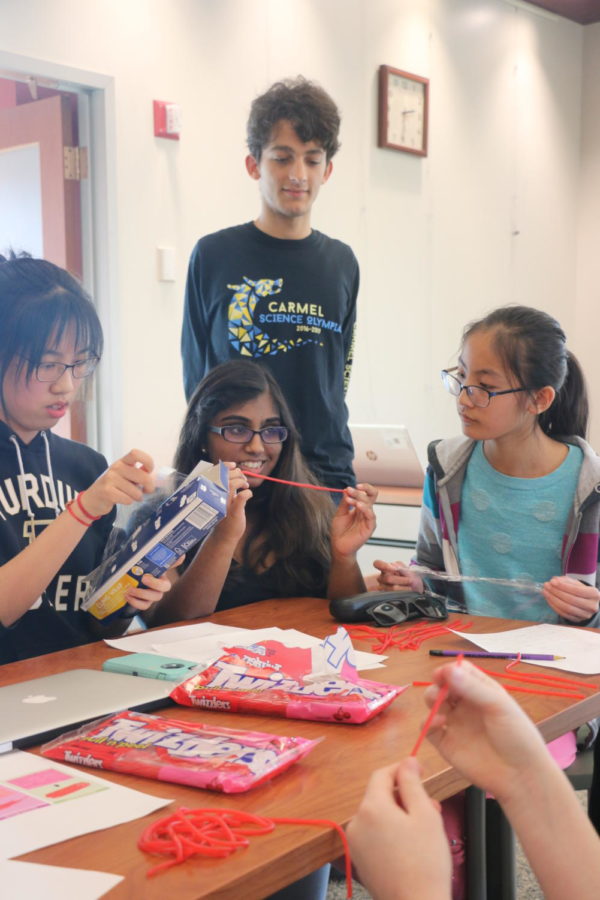Senior Nicole Segaran
Segaran uses Twizzlers as bundles of muscle fibers in a demonstration, peeling a Twizzler to simulate a muscle cell on Nov. 10 at the Carmel Clay Public Library. Segaran said she thinks it is important to get students interested in science from a young age and help them find their passions early in life.

Nicole Segaran, co-founder of the club Science Works and senior, emphasizes her point with jazz hands as she presents a slideshow about the human body and various anatomical structures to a group of middle schoolers at the anatomy workshop she led on Nov. 10 at the Carmel Clay Public Library. Segaran said that she believes that the time for women in STEM is now and that women should not be afraid to follow their passions.
Can you describe your involvement in STEM?
I’ve taken almost all of the AP STEM classes, like AP physics, AP bio, all that stuff. Also, I co-founded a club here at school called Science Works, dedicated to putting on science workshops for middle schoolers at the Carmel Clay Public Library—basically teaching about certain science topics that are more advanced than what they would see in a normal classroom setting. Also, I do research outside of school at Purdue University. I’ve been doing that since 10th grade— not (always) at Purdue, but at various places.
The project I did last year, I actually took to the International Science and Engineering Fair (ISEF) and won second place at it. Basically, we wanted to look at how glioblastoma, which is a brain cancer, is very deadly because the individual glioblastoma cells will migrate throughout the brain very rapidly, causing the brain cancer to spread to areas that couldn’t be surgically removed. We wanted to create a microscope that is able to track cell migration in a single cell culture because, right now, there are a lot of limitations on the methodology for tracking cell migration. We basically created a microscope that was capable of doing that in three dimensions, and we applied it to looking at how glioblastoma migration changes when we inhibit a certain receptor called a “sigma-1 receptor.”
This year, (my research) is a lot more laid-back. I don’t know how far we will get with it, but we are looking into how we can improve machine learning for identifying glioblastoma based on using this complex neural network algorithm to create more images. The main problem of machine learning is that there isn’t enough data to train these algorithms.
What drew you to STEM, and especially to topics of brain cancer and glioblastoma?
I’ve always loved STEM ever since I was little. It’s just something I naturally picked up on my own, and my dad was a huge component of that too. He used to give me lectures on science, as dads do. But for brain cancer in particular, I’ve always been really interested in how the brain works, especially how certain diseases can make normal brain functions work to their advantage—like how glioblastoma uses cancer cell migration to work to its advantage. That’s kind of what led me to research more about brain cancer and got me interested in that very niche subject.
How has STEM impacted your identity?
I’ve always considered myself as a very science-oriented person, even though I love the humanities. A lot of my passions and hobbies are actually humanities-related. I love to write and read, but even the approach I take to those hobbies is very scientific in my process and very analytical. Science has defined the way I look at the rest of the world and the way I approach my life.
Given your humanities-related passions in addition to your STEM activities, how do you balance humanities and STEM?
I think that rather than focusing on them as two separate things, which a lot of people do, I like to integrate them. Seeing how science applies to humanities is one of the reasons why I love interdisciplinary science and why I have so many hobbies across the spectrum because there’s actually a lot of overlap between the two. They can work hand-in-hand in a lot of really cool ways that I feel like a lot of students don’t know about.
What has your experience been like as a female in STEM?
Thankfully, it’s been pretty positive. There’s a lot of movement for women in STEM now to really get out there and find their niche. In fact, just this year, National Geographic posted about the science fair (ISEF) I went to, saying how the time is now for women in STEM, and talking about the science fair and how it fosters women in STEM.
Obviously, there have been some negative experiences. I’ve noticed that if you are a woman in STEM, no one’s going to blatantly be sexist towards you or undermine you, but there are some subtle things that make it more difficult to be a woman in STEM. For example, the fact that the majority of people in STEM are still male, and they listen a little bit less to women. I’ve even noticed how sometimes, when I’m talking to another person in STEM who is not my gender, they will be less likely to listen to me than to listen to, say, one of my peers who is a male. That’s not something that they even realize that they’re doing, it’s just something that, subconsciously, they tend to do. Equality is just something that we have to keep working towards.
There is a lot of belief that women in STEM aren’t as feminine and that they don’t care as much about the way they look, and they might not be as fun to be around. But actually, some of the most interesting people I’ve met, especially the most interesting women I’ve met, have been in fields of STEM. So if I had any advice for a woman in STEM right now—don’t feel like you need to follow the stereotypes and that you need to confine yourself to what other people believe you to be. And if you do follow that stereotype, don’t be afraid about that either. Just do whatever works best for you.
Any additional remarks?
Going off of that National Geographic article, I really do believe that the time for women in STEM is now. If going into STEM is something that, because of your background or because of your personality, you have been hesitant about doing because you are a woman, I would say just go for it. Just try your hardest, and you’ll really enjoy every moment of it.










